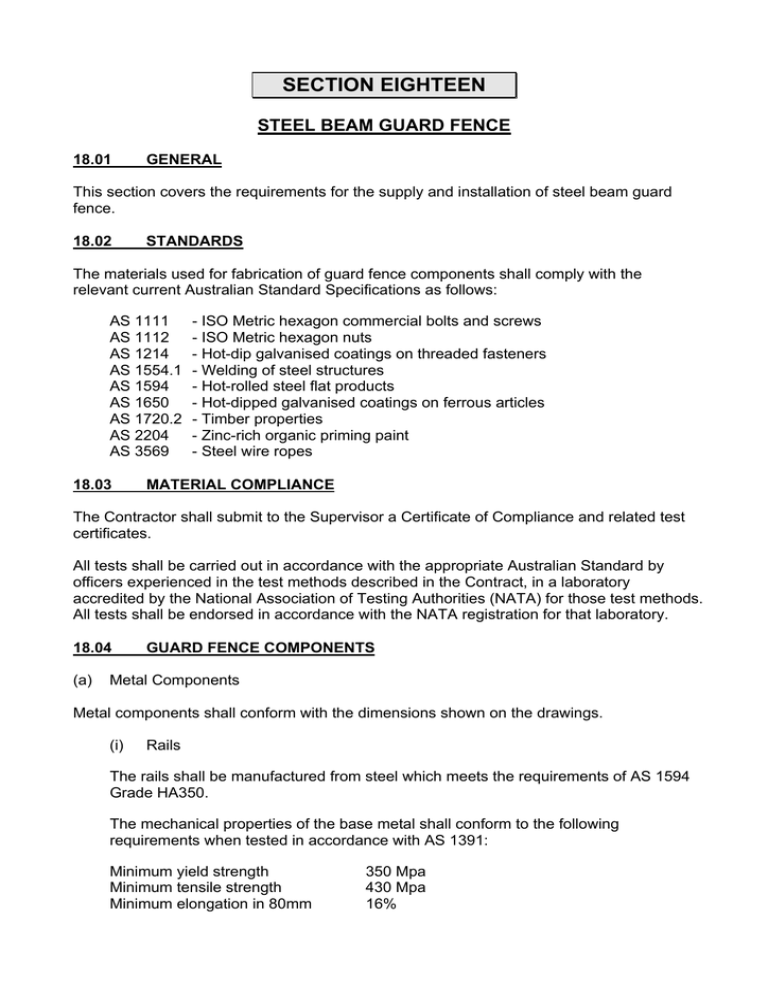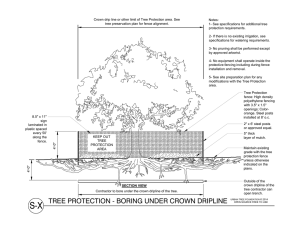SECTION EIGHTEEN
advertisement

SECTION EIGHTEEN STEEL BEAM GUARD FENCE 18.01 GENERAL This section covers the requirements for the supply and installation of steel beam guard fence. 18.02 STANDARDS The materials used for fabrication of guard fence components shall comply with the relevant current Australian Standard Specifications as follows: AS 1111 AS 1112 AS 1214 AS 1554.1 AS 1594 AS 1650 AS 1720.2 AS 2204 AS 3569 18.03 - ISO Metric hexagon commercial bolts and screws - ISO Metric hexagon nuts - Hot-dip galvanised coatings on threaded fasteners - Welding of steel structures - Hot-rolled steel flat products - Hot-dipped galvanised coatings on ferrous articles - Timber properties - Zinc-rich organic priming paint - Steel wire ropes MATERIAL COMPLIANCE The Contractor shall submit to the Supervisor a Certificate of Compliance and related test certificates. All tests shall be carried out in accordance with the appropriate Australian Standard by officers experienced in the test methods described in the Contract, in a laboratory accredited by the National Association of Testing Authorities (NATA) for those test methods. All tests shall be endorsed in accordance with the NATA registration for that laboratory. 18.04 (a) GUARD FENCE COMPONENTS Metal Components Metal components shall conform with the dimensions shown on the drawings. (i) Rails The rails shall be manufactured from steel which meets the requirements of AS 1594 Grade HA350. The mechanical properties of the base metal shall conform to the following requirements when tested in accordance with AS 1391: Minimum yield strength Minimum tensile strength Minimum elongation in 80mm 350 Mpa 430 Mpa 16% The base metal shall comply with the following tolerances when measured in accordance with AS 1365: Base metal thickness Mill tolerance on strip width Mill camber tolerance on 2000mm length 2.7mm 0.21mm 2.5mm, -0.0 4.0mm maximum For guard fence erected as barrier railing on bridges and major culverts the base material shall comply with the following tolerances when measured in accordance with AS 1365: Base metal thickness Mill tolerances on strip width Mill camber tolerance on 2000mm length (ii) 3.00mm 0.23mm 2.5mm, -0.0 8.0mm maximum Steel Posts and Blocks Steel posts and blocks shall be manufactured from steel which meets the requirements of AS 1594 Grade HU250. The base material thickness shall be 6.00mm 0.29mm. (iii) Bullnoses Bullnoses shall be manufactured from steel which meets the requirements of AS 1594 Grade HU250. (iv) Breakaway Cable Terminal The wire rope shall comply with the requirements of AS 3569. (b) Galvanising All steel components shall be hot-dip galvanised after fabrication. Before galvanising, the components shall be treated in accordance with the requirements of AS 1627 - Parts 1 and 4, “Code of Practice for Preparation and Pretreatment of Metal Surfaces prior to Protective Coating”. Galvanising on all components other than bolts, nuts and washers shall comply with AS 1650. The minimum zinc coating shall be 900 g/m2 (total both sides) for beams and terminals and 1200 g/m2 (total both sides) for steel posts and blocks. Galvanised coatings shall be smooth, adherent and free from stains, gross surface imperfections and inclusions. Appearance is of prime importance and colour shall be uniform. Hot dip galvanised coating on bolts, nuts and washers shall comply with AS 1214, Hot-Dip Galvanised Coatings on Threaded Fasteners. Where the galvanising on guard rail or associated fittings has been damaged, the coating shall be repaired by regalvanising or by painting with a minimum of two coats of zinc-rich inorganic paint in accordance with AS 2204 and one coat of aluminium paint. (c) Timber Timber posts and blocks shall be supplied to the dimensions shown on the drawings. Timber posts and blocks shall be seasoned timber dried to equilibrium moisture content and sawn from species complying with Class 1 or 2 durability and stress grading as specified on the drawings. All timber shall be straight and sound, and free from shakes, pipes, cores, flaws and other imperfections. The timber shall be sawn parallel to the grain, and exposed knots shall be sound, tight, well spaced and shall not exceed 25mm in size in any face. (d) Concrete Concrete for guard fence footings shall comply with the requirements of Section 5 ‘Concrete’. 18.05 INSTALLATION Prior to installation the Contractor shall confirm with the Superintendent the required location and length of all guard fence. The guard fence shall be installed at the positions so confirmed and shall be constructed true to line and level. (a) Posts Posts shall be installed to a depth not less than that shown on the drawings. Steel posts shall be orientated to the direction or traffic as shown the drawings. Where posts are driven into the ground this shall be by methods that do not result in any damage to the post. All post holes in rock shall have a 75mm minimum clearance from the back of the post to the face of the hole. Except for anchorage posts, post holes in rock shall be backfilled with granular material. Other post holes shall be backfilled with selected earth, free of rock. The backfilling shall be firmly compacted in layers not exceeding 100mm compacted thickness. Where posts are located in areas to be paved with concrete or premixed bituminous material, the backfilling of the post holes shall be finished 50mm below the underside of such paving and the remaining depth of the holes shall be filled and compacted with material similar to the surrounding material. The hollow steel posts adjacent to bridge abutments shall be set in mix concrete (strength grade 15 MPa) or cement treated crushed rock and filled with concrete as shown in the standard drawings. Surplus excavated material remaining after the guard fence has been constructed shall be disposed of off site by the Contractor. (b) Rails The guard rail sections shall be lapped so that the exposed ends face away from near-side approaching traffic. The edges of the guard rail section or backing plate adjacent to posts shall be fixed in contact with the post or post blocks and all bolts shall be fully tightened. When the radius of curvature is 50m or less, the guard rail sections shall be curved to shape prior to delivery to the site. End treatments of the types specified shall be constructed in accordance with the details shown the drawings. Posts attached to bridges and culverts shall be bolted to supporting members and/or set on mortar pads as shown on the drawings. (c) Anchorages The anchor cable shall be tightened sufficiently to remove slack. (d) Line and Level After installation the top of the rail shall be within 25mm of the specified level and 50mm of the specified line. Variations from specified line and level shall not occur at a rate exceeding 15mm in any 5m length. Notwithstanding these requirements the line and level of the guard fence shall be adjusted where necessary to provide a smooth and even vertical and horizontal alignment.

